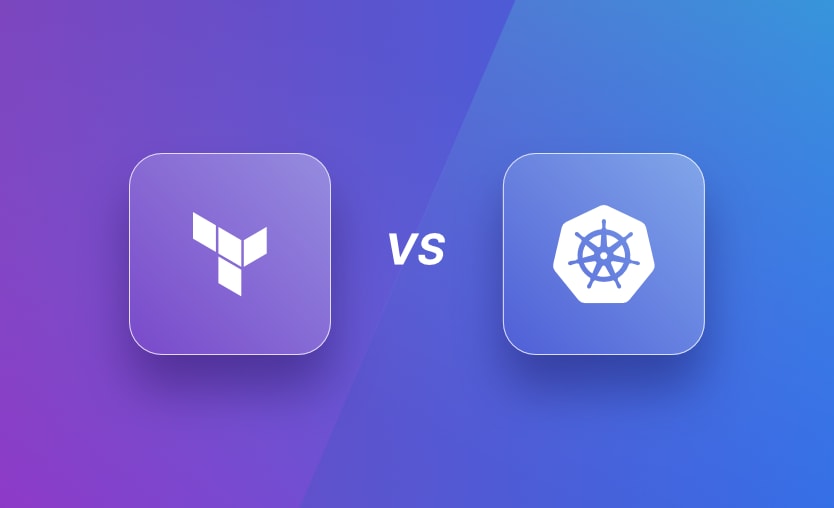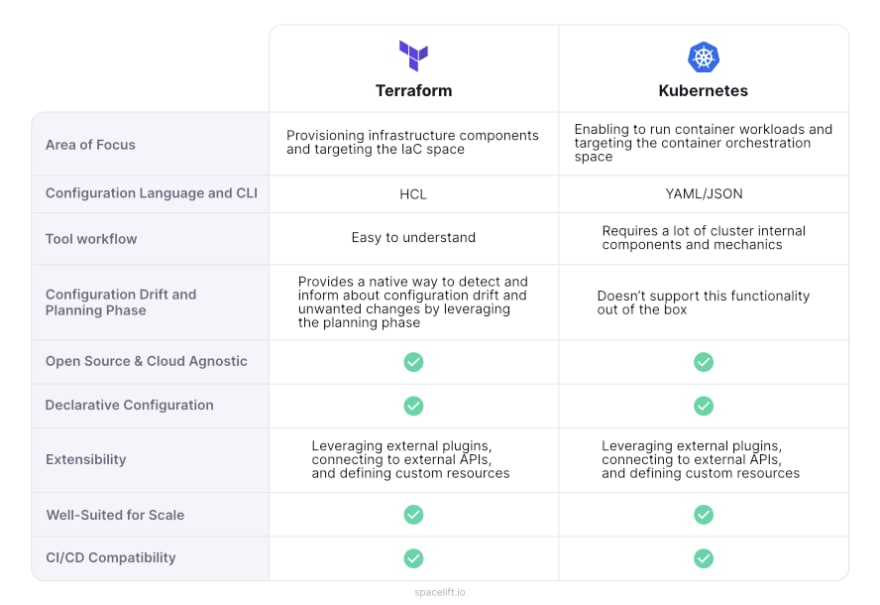This article will compare two of the most dominant tools in the cloud infrastructure space, Terraform and Kubernetes. These two tools share some similarities but are built to serve different purposes. Terraform is a tool focused on infrastructure provisioning and operates in the Infrastructure as code space. Kubernetes focuses on running container workloads and operates in the container orchestration space.
We will briefly take a look at each one of them and discuss their similarities and differences.
To learn more about these two foundational cloud infrastructure technologies, check the multiple tutorials on Spacelift’s blog around Kubernetes and Terraform.
Terraform in a Nutshell
Terraform is an open-source software tool that allows us to safely and predictably manage infrastructure at scale using cloud-agnostic and infrastructure as code principles. It is a powerful tool developed by Hashicorp that enables infrastructure provisioning both on the cloud and on-premises.
Terraform is written in a declarative configuration language, Hashicorp Configuration Language (HCL), and facilitates the automation of infrastructure management in any environment. It allows IT professionals to collaborate and perform changes safely on cloud environments and scale them on-demand according to the business needs.
Modules provide excellent reusability and code-sharing opportunities to boost the collaboration and productivity of teams operating on the cloud. Providers are plugins that offer integration and interaction with different APIs and are one of the main ways to extend Terraform’s functionality.
Terraform keeps an internal state of the managed infrastructure, which represents resources, configuration, metadata, and their relationships. The state is actively maintained by Terraform and utilized to create plans, track changes, and enable modifications of infrastructure environments. The state should be stored remotely to allow teamwork and collaboration as a best practice.
The core Terraform workflow consists of three concrete stages. First, we generate the infrastructure as code configuration files representing our environment’s desired state. Next, we check the output of the generated plan based on our manifests. After carefully reviewing the changes, we apply the plan to provision infrastructure resources.
Kubernetes in a Nutshell
Kubernetes (K8s) is an open-source system for container orchestration, automating deployments, and managing containerized apps. Its powerful orchestration system enables applications to scale seamlessly and achieve high availability. It has been designed and developed by Google, leveraging its vast experience in running and maintaining critical workloads in production.
Kubernetes strives to be cloud agnostic at its core, providing great flexibility in running workloads across cloud and on-premises environments. Additionally, it is designed with extensibility in mind, providing the option to add features and custom tooling to clusters easily.
One of its main benefits is the self-healing capabilities it provides. Containers that fail are automatically restarted and rescheduled, nodes can be configured to be automatically replaced, and traffic is served only by healthy components based on health checks.
Rollouts are handled progressively, and Kubernetes provides smart mechanisms to monitor application health during deployments. Rolling back problematic changes happens automatically if the application health doesn’t report a healthy status after a new deployment. Keeping the application running while rolling out new software versions has been a hot topic in the Kubernetes ecosystem over the past years, with many possible deployment strategies.
Kubernetes handles service discovery and load-balances traffic between similar pods natively without the need for complex external solutions. It has extendable built-in mechanisms to manage configuration and secrets for your applications. Scaling your applications has never been easier since it provides autoscaling options, scaling through commands, or via a UI.
Kubernetes provides a cluster of nodes, a group of worker machines that run containerized applications. Each node hosts pods that hold application workload containers. The brain of the whole system is the control plane. Each cluster consists of several components that manage the worker nodes and pods and guarantee operational continuity.
The API server is the component exposing the Kubernetes API and operates as the front-end of the control plane by handling all the communication between other parts. The etcd component is used to store all cluster data and state. The scheduler manages how pods are assigned to nodes and takes all the workload scheduling decisions. The controller manager components run different controller processes to ensure that the cluster’s desired state matches its current state. The cloud controller manager integrates Kubernetes clusters with external cloud providers, embeds their logic, and links the Kubernetes API with the Cloud Provider’s API. On each node, the kubelet is the agent responsible for running containers in pods, and kube-proxy is the component that adds the necessary networking capabilities for communication between pods and nodes.
Check out this article to learn more about the Key Kubernetes Cluster Components.

Kubernetes and Terraform Differences
These two modern technologies have many similarities but also fundamental differences. Let’s look into some of them in more detail.
1) Area of Focus
First and foremost, Terraform and Kubernetes have different purposes and try to solve different problems. Terraform focuses on provisioning infrastructure components and targets the Infrastructure as Code space. Kubernetes aims to enable us to run container workloads and targets the container orchestration space.
2) Configuration Language and CLI
Manifests in Terraform are written in HCL language, while in Kubernetes in YAML or JSON. Each tool has its own command line utility and tool-specific internals to understand before being productive.
3) Tool workflow
The Terraform workflow is generally considered easy to understand and provides a welcoming experience for new users. On the other hand, to be effective in running applications in Kubernetes, one has to understand a lot of cluster internal components and mechanics, and usually, it takes more time for users to get up to speed with Kubernetes.
4) Configuration Drift & Planning Phase
Terraform provides a native way to detect and inform you about configuration drift and unwanted changes by leveraging the planning phase of the typical workflow. In contrast, Kubernetes doesn’t support this functionality out of the box.
Kubernetes and Terraform Similarities
1) DevOps Tools
Both tools operate in the DevOps space and are typically set up and configured by the same type of IT practitioners; Site Reliability, DevOps, and Cloud engineers.
2) Open Source & Cloud Agnostic
Both tools are open source with various contributions by their online communities. They also take a similar approach to striving to be as cloud, platform, and API agnostic as possible to accommodate workloads across different environments. Even though they try to keep the core of the projects agnostic to external providers, both tools have mature and actively maintained integrations with the most common cloud providers.
3) Declarative Configuration
Although they use different languages, Terraform and Kubernetes take a similar approach conceptually to define the configuration. Manifests in both tools are written with the declarative approach.
4) State Management
The notion of the state exists in both tools, although it is implemented differently. Terraform and Kubernetes apply some logic to reconcile the desired state configured in declarative configuration files with the running state.
5) Extensibility
Both tools are highly extensible by leveraging external plugins, connecting to external APIs, or defining custom resources if necessary.
6) Well-Suited for Scale
Terraform and Kubernetes are battle-tested technologies that can support huge scale since they are designed and architected with scaling considerations for modern cloud-native environments.
7) CI/CD Compatibility
Since both tools offer highly and easily automatable workflows, they can be integrated and combined with CI/CD pipelines to automate their lifecycle.
Kubernetes and Terraform Synergies
By decomposing all the information we discussed, we realize that Kubernetes and Terraform complement each other since they operate at two different levels and can be utilized in parallel.
A typical model that cloud practitioners adopt is to use Terraform to provision infrastructure resources (e.g. Kubernetes clusters) and use Kubernetes to manage the containerized apps that run on top of the clusters.
Terraform’s approach simplifies and standardizes the complex task of provisioning Kubernetes clusters. Terraform, in this case, enables a unified flow for provisioning Kubernetes clusters across providers with a declarative approach that is preferred over command line utilities. This approach works great, but users must use separate flows to manage infrastructure and application resources.
Another approach is to use Terraform to manage Kubernetes-specific application components as well. This model has the advantage of adding the Terraform workflow to Kubernetes components. This way, IT operators can detect configuration drift on Kubernetes and manage infrastructure and application resources with the same workflow and configuration language.
This approach has a significant disadvantage since Terraform requires a well-defined schema for each managed resource. Thus each Kubernetes resource needs to be translated into a Terraform schema to be available. This dependency makes maintaining Kubernetes resources through Terraform cumbersome at times.
Kubernetes and Terraform with Spacelift
Spacelift supports both Terraform and Kubernetes and enables users to create stacks based on them. Leveraging Spacelift, you can build CI/CD pipelines to combine them and get the best of each tool. This way, you will use a single tool to manage your Terraform and Kubernetes resources lifecycle, allow your teams to collaborate easily, and add some necessary security controls to your workflows.
You could, for example, deploy Kubernetes clusters with Terraform stacks and then, on separate Kubernetes stacks, deploy your containerized applications to your clusters. With this approach, you can easily integrate drift detection into your Kubernetes stacks and enable your teams to manage all your stacks from a single place.
To take this one step further, you could add custom policies to harden the security and reliability of your configurations and deployments. Spacelift provides different types of policies and workflows easily customizable to fit every use case. You could, for instance, add plan policies to restrict or warn about security or compliance violations or approval policies to add an approval step during deployments. The possibilities are endless with Spacelift since it provides a great way to blend Terraform and Kubernetes and enhance their capabilities with extra functionality.
Take a look at the Getting Started Guide to liftoff with Spacelift!
Key Points
We delved into two of the most used modern DevOps tools, Kubernetes and Terraform. We discovered what makes each of them appealing and what functionalities they provide to IT operators and developers. We discussed their similarities, differences, and synergies and explored ways to combine them with Spacelift.
Thank you all for reading, and I hope you enjoyed this as much as I did.









Oldest comments (0)